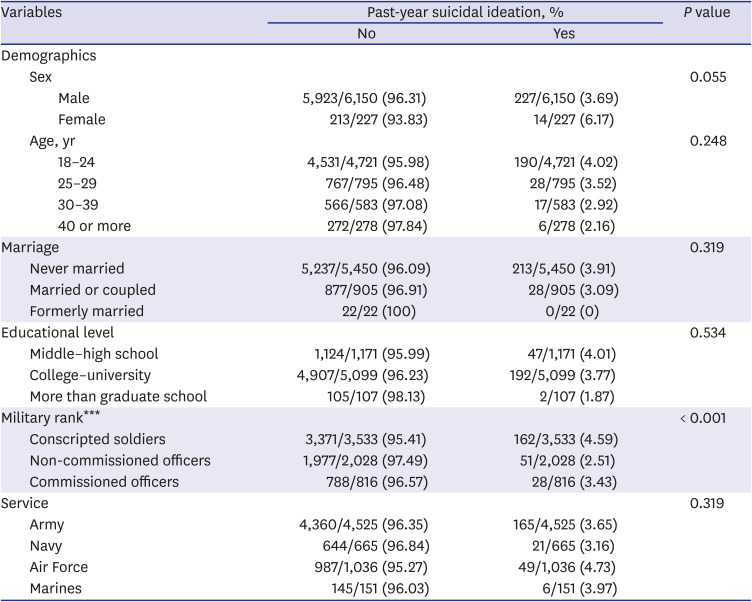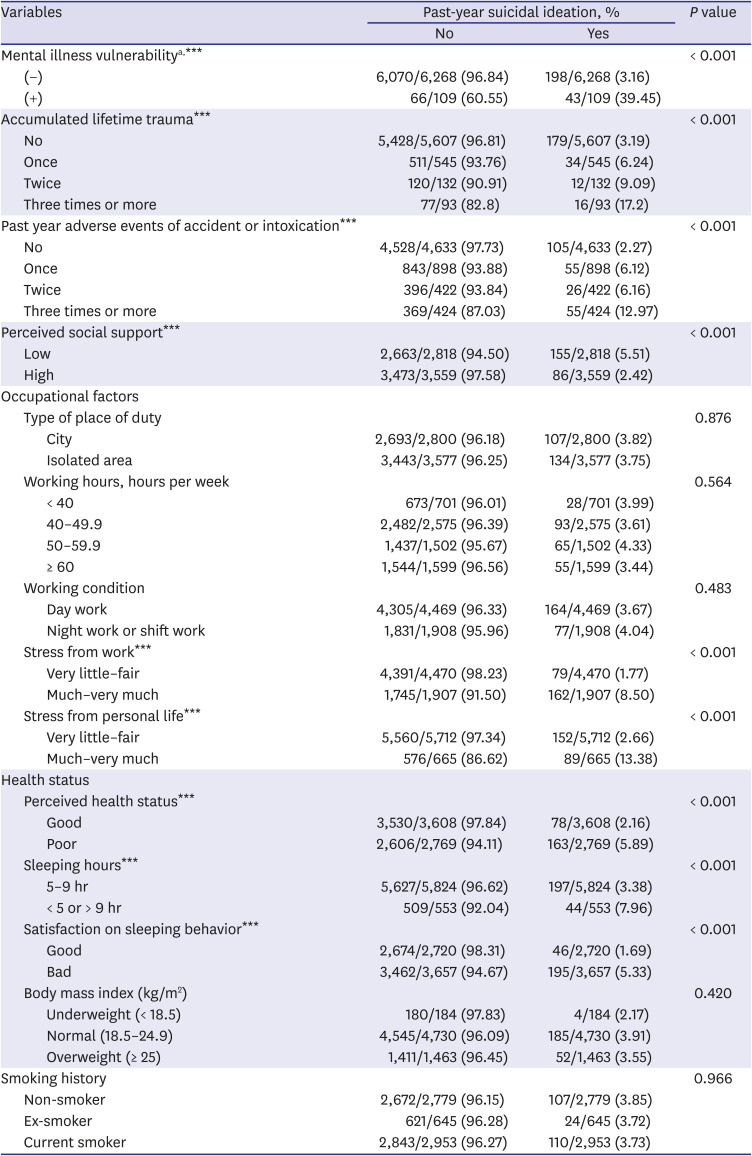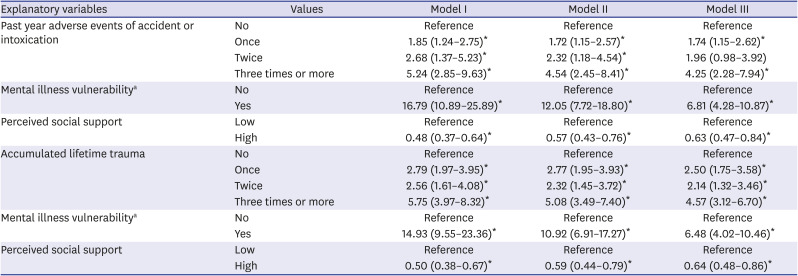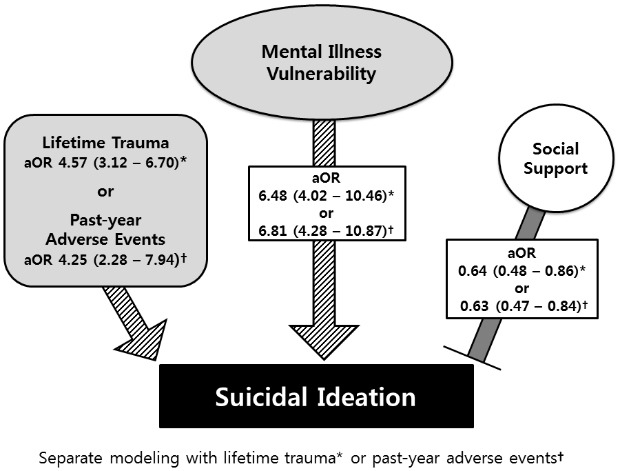1. World Health Organization. Preventing Suicide: a Global Imperative. Geneva: World Health Organization;2014.
3. Laukkala T, Partonen T, Marttunen M, Henriksson M. Suicides among military conscripts between 1991–2007 in Finland--a descriptive replication study. Nord J Psychiatry. 2014; 68(4):270–274. PMID:
23957461.


4. Schoenbaum M, Kessler RC, Gilman SE, Colpe LJ, Heeringa SG, Stein MB, et al. Predictors of suicide and accident death in the Army Study to Assess Risk and Resilience in Servicemembers (Army STARRS): results from the Army Study to Assess Risk and Resilience in Servicemembers (Army STARRS). JAMA Psychiatry. 2014; 71(5):493–503. PMID:
24590048.


5. Shelef L, Kaminsky D, Carmon M, Kedem R, Bonne O, Mann JJ, et al. Risk factors for suicide attempt among Israeli Defense Forces soldiers: a retrospective case-control study. J Affect Disord. 2015; 186:232–240. PMID:
26253904.


6. Wilcox HC, Storr CL, Breslau N. Posttraumatic stress disorder and suicide attempts in a community sample of urban American young adults. Arch Gen Psychiatry. 2009; 66(3):305–311. PMID:
19255380.



7. Stein DJ, Chiu WT, Hwang I, Kessler RC, Sampson N, Alonso J, et al. Cross-national analysis of the associations between traumatic events and suicidal behavior: findings from the WHO World Mental Health Surveys. PLoS One. 2010; 5(5):e10574. PMID:
20485530.

8. Wesseling C, van Wendel de Joode B, Keifer M, London L, Mergler D, Stallones L. Symptoms of psychological distress and suicidal ideation among banana workers with a history of poisoning by organophosphate or n-methyl carbamate pesticides. Occup Environ Med. 2010; 67(11):778–784. PMID:
20798019.


9. Panagioti M, Gooding PA, Tarrier N. A meta-analysis of the association between posttraumatic stress disorder and suicidality: the role of comorbid depression. Compr Psychiatry. 2012; 53(7):915–930. PMID:
22483367.


10. Harris LM, Huang X, Linthicum KP, Bryen CP, Ribeiro JD. Sleep disturbances as risk factors for suicidal thoughts and behaviours: a meta-analysis of longitudinal studies. Sci Rep. 2020; 10(1):13888. PMID:
32807889.



11. Sutaria S, Devakumar D, Yasuda SS, Das S, Saxena S. Is obesity associated with depression in children? Systematic review and meta-analysis. Arch Dis Child. 2019; 104(1):64–74. PMID:
29959128.


12. Perera S, Eisen RB, Dennis BB, Bawor M, Bhatt M, Bhatnagar N, et al. Body mass index is an important predictor for suicide: results from a systematic review and meta-analysis. Suicide Life Threat Behav. 2016; 46(6):697–736. PMID:
27094229.


13. Afifi TO, Taillieu T, Zamorski MA, Turner S, Cheung K, Sareen J. Association of child abuse exposure with suicidal ideation, suicide plans, and suicide attempts in military personnel and the general population in Canada. JAMA Psychiatry. 2016; 73(3):229–238. PMID:
26817953.


14. Bishop TM, Walsh PG, Ashrafioun L, Lavigne JE, Pigeon WR. Sleep, suicide behaviors, and the protective role of sleep medicine. Sleep Med. 2020; 66:264–270. PMID:
31727433.


15. Bryan CJ, Rudd MD, Wertenberger E, Young-McCaughon S, Peterson A. Nonsuicidal self-injury as a prospective predictor of suicide attempts in a clinical sample of military personnel. Compr Psychiatry. 2015; 59:1–7. PMID:
25749478.


16. Bryan CJ, Bryan AO, Clemans TA. The association of military and premilitary sexual trauma with risk for suicide ideation, plans, and attempts. Psychiatry Res. 2015; 227(2-3):246–252. PMID:
25863823.


17. McLean CP, Zang Y, Zandberg L, Bryan CJ, Gay N, Yarvis JS, et al. Predictors of suicidal ideation among active duty military personnel with posttraumatic stress disorder. J Affect Disord. 2017; 208:392–398. PMID:
27810723.

18. Roy A, Sarchiapone M, Carli V. Low resilience in suicide attempters. Arch Suicide Res. 2007; 11(3):265–269. PMID:
17558611.


19. Pietrzak RH, Goldstein MB, Malley JC, Rivers AJ, Johnson DC, Southwick SM. Risk and protective factors associated with suicidal ideation in veterans of operations enduring freedom and Iraqi freedom. J Affect Disord. 2010; 123(1-3):102–107. PMID:
19819559.


20. An HJ, Kwon SC, Kim HM. Factors that influence non-combat military soldiers' suicidal ideation. J Korean Acad Psychiatr Ment Health Nurs. 2010; 19(3):299–306.

21. Kim H, Keum R, Kim S, Park SI, Park JY. Military stress, stress coping, and mental health status among soldiers who need intensive care. J Korean Acad Psychiatr Ment Health Nurs. 2013; 22(4):285–294.

22. Lee AY, Lee HW, Jo SJ, Yim HW, Jang S, Park JI. The correlation between stress, depression, and social relations of Korean soldiers with a history of suicidal behavior. J Korean Neuropsychiatr Assoc. 2018; 57(4):323–331.

23. Kim TK, Lee SG, Han KT, Choi Y, Lee SY, Park EC. The association between perceived unmet medical need and mental health among the Republic of Korea Armed Forces. J R Army Med Corps. 2017; 163(3):184–192. PMID:
27660285.


24. Franklin JC, Ribeiro JD, Fox KR, Bentley KH, Kleiman EM, Huang X, et al. Risk factors for suicidal thoughts and behaviors: a meta-analysis of 50 years of research. Psychol Bull. 2017; 143(2):187–232. PMID:
27841450.


25. Berardelli I, Corigliano V, Hawkins M, Comparelli A, Erbuto D, Pompili M. Lifestyle interventions and prevention of suicide. Front Psychiatry. 2018; 9:567. PMID:
30459660.



27. Gray MJ, Litz BT, Hsu JL, Lombardo TW. Psychometric properties of the life events checklist. Assessment. 2004; 11(4):330–341. PMID:
15486169.


28. Kessler RC, Barker PR, Colpe LJ, Epstein JF, Gfroerer JC, Hiripi E, et al. Screening for serious mental illness in the general population. Arch Gen Psychiatry. 2003; 60(2):184–189. PMID:
12578436.


29. Furukawa TA, Kessler RC, Slade T, Andrews G. The performance of the K6 and K10 screening scales for psychological distress in the Australian National Survey of Mental Health and Well-Being. Psychol Med. 2003; 33(2):357–362. PMID:
12622315.


30. Min JW, Lee SH. Validation of the K6/K10 scales of psychological distress and their optimal cutoff scores for older Koreans. Int J Aging Hum Dev. 2015; 80(3):264–282. PMID:
26195502.


31. Holma KM, Melartin TK, Haukka J, Holma IA, Sokero TP, Isometsä ET. Incidence and predictors of suicide attempts in DSM-IV major depressive disorder: a five-year prospective study. Am J Psychiatry. 2010; 167(7):801–808. PMID:
20478879.

32. Tsai AC, Lucas M, Sania A, Kim D, Kawachi I. Social integration and suicide mortality among men: 24-year cohort study of U.S. health professionals. Ann Intern Med. 2014; 161(2):85–95. PMID:
25023247.



33. Tsai AC, Lucas M, Kawachi I. Association between social integration and suicide among women in the United States. JAMA Psychiatry. 2015; 72(10):987–993. PMID:
26222043.



34. Park JW. A study to development a scale of social support [dissertation]. Seoul: Yonsei University;1985.
35. Yoon CG, Bae KJ, Kang MY, Yoon JH. Is suicidal ideation linked to working hours and shift work in Korea? J Occup Health. 2015; 57(3):222–229. PMID:
25752659.


36. Roy A, Hu XZ, Janal MN, Goldman D. Interaction between childhood trauma and serotonin transporter gene variation in suicide. Neuropsychopharmacology. 2007; 32(9):2046–2052. PMID:
17356577.


37. Risch N, Herrell R, Lehner T, Liang KY, Eaves L, Hoh J, et al. Interaction between the serotonin transporter gene (5-HTTLPR), stressful life events, and risk of depression: a meta-analysis. JAMA. 2009; 301(23):2462–2471. PMID:
19531786.


38. Debeer BB, Kimbrel NA, Meyer EC, Gulliver SB, Morissette SB. Combined PTSD and depressive symptoms interact with post-deployment social support to predict suicidal ideation in operation enduring freedom and operation Iraqi freedom veterans. Psychiatry Res. 2014; 216(3):357–362. PMID:
24612971.



39. Belik SL, Stein MB, Asmundson GJ, Sareen J. Are Canadian soldiers more likely to have suicidal ideation and suicide attempts than Canadian civilians? Am J Epidemiol. 2010; 172(11):1250–1258. PMID:
20978087.










 PDF
PDF Citation
Citation Print
Print




 XML Download
XML Download